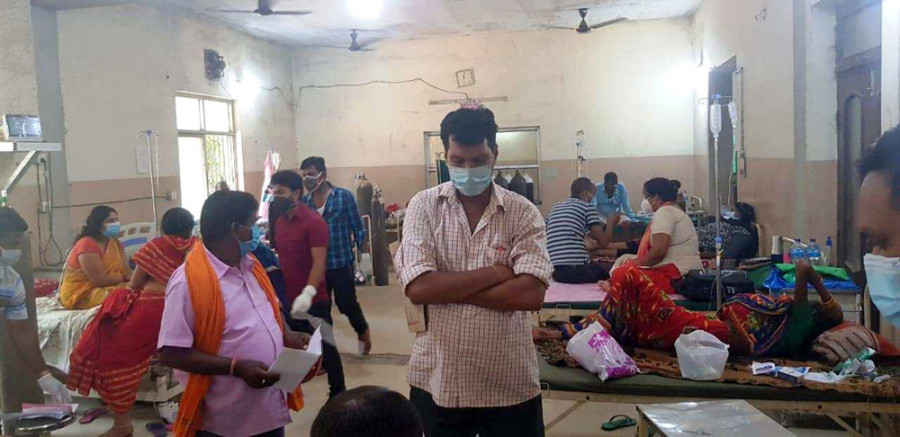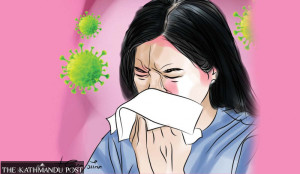Health
Covid-19 peak yet to arrive, warn experts as they stress curbing infections
Doctors say increasing number of beds and keeping an eye on possible hoarding of oxygen cylinders, as well as expanding testing, should be immediate priority.
Arjun Poudel
With the government sending a message that the health system is not able to cope with the soaring number of coronavirus infections, the general public is left to fend for themselves.
With oxygen therapy a fundamental treatment of the disease, people have started hoarding oxygen cylinders at home.
“What is worrying is that cylinders have stopped coming back to the industry for refilling,” Shambhu Bhandari, manager of Shankar Oxygen Gas in Balaju, told the Post. “As risks have increased, people in need will not get the oxygen on time if cylinders get stocked at homes.”
News of mounting deaths due to oxygen shortage in India has also been a catalyst for the public to hoard oxygen cylinders at home.
“Demand for oxygen cylinders has risen several fold over the last few days,” said Bhandari. “We do not have a record of people taking oxygen cylinders from our company as we have limited staff and there are too many people who are here to get oxygen.”
But such would not have been the situation if the government had made the necessary preparations to treat the sick, say experts.
“It is not the time to surrender, as the peak of the second wave is yet to come,” Dr Prabhat Adhikari, an infectious disease and critical care expert, told the Post.
“All available resources should be used for saving lives.”
On Saturday, of the polymerase chain reaction tests conducted on samples collected from 14,403 people across the country, 5,706 tested positive, which means a positivity rate of 39.6 percent. An additional 57 samples tested positive in antigen tests.
What is alarming is the R, or reproductive, number of the virus, which shows how easily one person can infect others, stands at a little over 2, a rate higher than in India. The southern neighbour is reporting its R number at a little over 1.
In the last 24 hours, 19 deaths from Covid-19 were recorded throughout Nepal. The number of active cases stands at 43,213. So far, 328,893 people have tested positive since the country reported its first Covid-19 case in the third week of January last year.
The death toll has reached 3,298.
The government has projected that the daily number of infections could be as high as 11,000 by mid-July. The total number of infected persons could rise up to 800,000 and 15,000 could need intensive care beds while 45,000 might require high flow oxygen therapy, according to the projection.
Doctors, however, say that the number of new cases could come down after two weeks if the restrictive measures are enforced strictly and people do not come out of their homes unnecessarily. Prohibitory orders are in place in about a third of the country.
But the government has sent a wrong message across—of the health system about to collapse, they say.
“What will we do when new cases hit 11,000 a day, which is projected by the government itself,” an official at the Department of Health Services told the post, asking not to be named as he is not authorised to speak with the media. “The government cannot surrender, as saving lives is its primary responsibility.”
As cases continue to spike, most hospitals—public and private—have stopped their out-patient services and postponed elective surgeries. Patients too have stopped visiting hospitals.
These beds, as well as those in private hospitals, can be used in the treatment of the infected people, according to doctors.
“If private hospitals have sufficient beds, sufficient human resources and the current problem is only a growing number of infections, why not use those resources?” Dr Bhagwan Koirala, chairman of Nepal Medical Council, told the Post. “Authorities should also use beds at state-run hospitals that have become vacant due to a decline in non-Covid patients.”
Telling the truth to the public is the duty of the government and when the government does not do that, people panic, according to him.
Doctors say that testing and contact tracing are still crucial in the lockdown period, which helps to make heat maps. As lockdown or restrictive measures cannot be extended for an indefinite period, heat maps need to be prepared to locate red, yellow and green zones on the extent of the spread of infections and to gradually lift the restrictions.
But even as the number of infections continues to soar, authorities have not increased testing and resumed contact tracing.
Along with starting necessary preparations on a war footing, authorities should also focus on purchasing vaccines at the earliest, without which the country cannot get rid of the menace of infections, doctors say.
Nepal at present does not have vaccines to give the second shots to the 1.3 million people over the age of 65 who got their first shot in March as India has banned the export of vaccines with cases there surging beyond control.
“America has stockpiled 60 million doses of the Oxford-AstraZeneca vaccine, which it is planning to distribute to many countries,” said Adhikari, the infectious disease and critical care expert. “We should activate our diplomatic channel to get some of them.”
But there are measures that the government can take by itself like establishing oxygen banks, which would ensure the supply of oxygen to the needy homes and hospitals.
“The suffering of the people can be eased and a lot of deaths averted by providing oxygen therapy to patients in critical conditions,” Dr Sher Bahadur Pun, chief of the Clinical Research Unit at Sukraraj Tropical and Infectious Disease Hospital, told the Post. “We can provide oxygen to the seriously aliling patients from community centres.”
But with the government not giving a sense that it is capable of helping out, people are taking matters into their own hands and this could prove detrimental.
“Patients will not survive by just taking oxygen at home if their condition deteriorates,” said Koirala. “Hoarding oxygen cylinders at home only exacerbates the problem and jeopardises the lives of many other infected people.”
Meanwhile, Minister for Health Hridayesh Tripathi said on Saturday that even though the infection rate is alarming, there is no need to panic.
In a video message posted on his Facebook page, Tripathi said that the government is working to arrange an additional 1,000 beds in Kathmandu.
“The government has not given up the fight,” said Tripathi. “The government is committed to its duty. The government is working to import vaccines and life-saving drugs.”




 16.12°C Kathmandu
16.12°C Kathmandu












%20(1).jpg&w=300&height=200)

